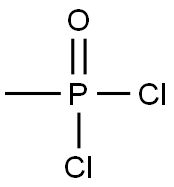METHYLPHOSPHONIC DICHLORIDE

- CAS No.
- 676-97-1
- Chemical Name:
- METHYLPHOSPHONIC DICHLORIDE
- Synonyms
- Methylphosphonyl dichloride;NA 9206;CH3POCl2;methylpho;methylphosphonylchloride;methanephosphonylchloride;dichlorophosphorylmethane;methylphosphonyldichloride;methyl-phosphonicdichlorid;METHYLPHOSPHONIC DICHLORIDE
- CBNumber:
- CB1391280
- Molecular Formula:
- CH3Cl2OP
- Molecular Weight:
- 132.91
- MOL File:
- 676-97-1.mol
- Modify Date:
- 2024/12/18 14:07:02
| Melting point | 31-34 °C |
|---|---|
| Boiling point | 163 °C(lit.) |
| Density | 1.468 g/mL at 25 °C(lit.) |
| vapor pressure | 760 mm Hg ( 163 °C) |
| Flash point | >110°C |
| solubility | Acetonitrile (Slightly), Chloroform |
| form | solid |
| Water Solubility | Soluble in water. |
| Sensitive | Moisture Sensitive |
| BRN | 1071305 |
| Stability | Stable, but may decompose in the presence of water or moisture. Incompatible with water, strong bases, strong oxidizing agents. |
| CAS DataBase Reference | 676-97-1 |
| EPA Substance Registry System | Methylphosphonic dichloride (676-97-1) |
SAFETY
Risk and Safety Statements
| Symbol(GHS) |   GHS05,GHS06 |
|||||||||
|---|---|---|---|---|---|---|---|---|---|---|
| Signal word | Danger | |||||||||
| Hazard statements | H314-H330 | |||||||||
| Precautionary statements | P260-P271-P280-P303+P361+P353-P304+P340+P310-P305+P351+P338 | |||||||||
| Hazard Codes | T+ | |||||||||
| Risk Statements | 14-26-34 | |||||||||
| Safety Statements | 26-36/37/39-45 | |||||||||
| RIDADR | UN 3390 6.1/PG 1 | |||||||||
| WGK Germany | 3 | |||||||||
| RTECS | TA1840000 | |||||||||
| F | 10 | |||||||||
| TSCA | Yes | |||||||||
| HazardClass | 6.1 | |||||||||
| PackingGroup | I | |||||||||
| Hazardous Substances Data | 676-97-1(Hazardous Substances Data) | |||||||||
| NFPA 704 |
|
METHYLPHOSPHONIC DICHLORIDE Chemical Properties,Uses,Production
Chemical Properties
Methyl phosphonic dichloride is a low melting solid or colorless to pale yellow liquid. Pungent odor.
Uses
suzuki reaction
Production Methods
The oxidation of lowvalency organophosphorus compounds is important mainly in the case of the thiophosphonic acid chlorides. This method is used in the production of methylphosphonic acid dichloride by reaction of methyldichlorophosphine with sulfuryl chloride or chlorosulfuric acid. Elemental sulfur reacts with MePCl2 in the presence of catalytic quantities of tetraalkylphosphonium salts to form methylthiophosphonic acid dichloride.
General Description
Strongly irritates skin. Contact may destroy or irreversibly alter skin tissue. Very toxic by ingestion, inhalation, or by skin absorption. Combustible, though may be difficult to ignite.
Air & Water Reactions
Fumes in moist air to form hydrogen chloride. Reacts with water to form hydrochloric acid, reaction may be violent.
Reactivity Profile
METHYLPHOSPHONIC DICHLORIDE is incompatible with water, strong oxidizing agents, alcohols, bases (including amines).. May react vigorously or explosively if mixed with diisopropyl ether or other ethers in the presence of trace amounts of metal salts [J. Haz. Mat., 1981, 4, 291].
Health Hazard
Poisonous if inhaled or swallowed. Contact causes severe burns to skin and eyes.
Fire Hazard
METHYLPHOSPHONIC DICHLORIDE may burn but does not ignite readily. May ignite other combustible materials (wood, paper, oil, etc.). Reacts violently with water. Flammable poisonous gases may accumulate in tanks and hopper cars. Runoff to sewer may create fire or explosion hazard. Contact causes severe burns to skin and eyes. Runoff from fire control or dilution water may cause pollution. Violent reaction with water.
Safety Profile
Poison by inhalation. A corrosive irritant to the eyes, skin, and mucous membranes. When heated to decomposition it emits toxic fumes of Cland POx.
Potential Exposure
Highly flammable; mists or Vapors may form explosive mixture with air. Reacts with moist air forming fumes of hydrogen chloride; may spontaneously ignite. Reacts with water or alcohol, forming hydrochloric acid. The reaction may be violent and ignite unreacted material. Incompatible with oxidizers (chlorates, nitrates, peroxides, permanganates, perchlorates, chlorine, bromine, fluorine, etc.); contact may cause fires or explosions. Keep away from alkaline materials, strong bases, strong acids, oxoacids, epoxides, amines, ethers. May react violently, possibly explosively, when mixed with ethers and trace amounts of metal salts.
Shipping
UN9206 Methyl phosphonic dichloride, Hazard class: 6.1; Labels: 6.1-Poisonous materials, 8-Corrosive material. Domestic (United States), Inhalation Hazard Zone B. UN3390 Toxic by inhalation liquid, corrosive, n.o.s. with an LC50 # 1000 mL/m3 and saturated vapor concentration ≥ 10 LC50 Hazard Class: 6.1; Labels: 6.1- Poisonous materials, 8-Corrosive material, Technical Name Required, Inhalation Hazard Zone B
Purification Methods
Methylphosphonic dichloride [676-97-1] M 132.9, m 33o, 33-37o, b 53-54o/10mm, 64-6 7o/20.5mm, 86o/44mm, 162o/760mm, d 4 1.4382. Fractionally redistil it until the purity as checked by hydrolysis and acidimetry for Clis correct and the distillate should solidify on cooling. [Kinnear & Perren J Chem Soc 3437 1952, Crofts & Kosolapoff J Am Chem Soc 75 3379 1952, for IR see McIvor et al. Can J Chem 34 1611 1956, Beilstein 4 IV 3509.]
Waste Disposal
Use a licensed professional waste disposal service to dispose of this material. Dissolve or mix the material with a combustible solvent and burn in a chemical incinerator equipped with an afterburner and scrubber. All federal, state, and local environmental regulations must be observed
METHYLPHOSPHONIC DICHLORIDE Preparation Products And Raw materials
676-97-1(METHYLPHOSPHONIC DICHLORIDE)Related Search:
1of4
chevron_right




